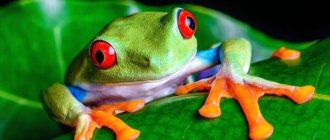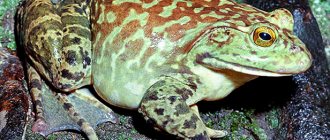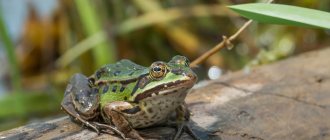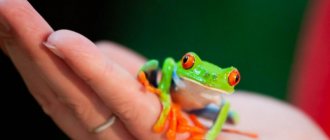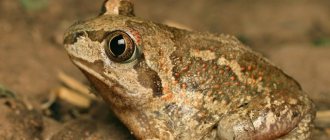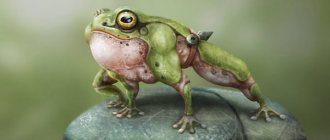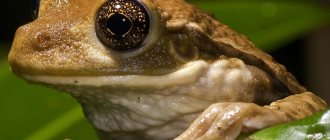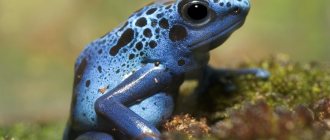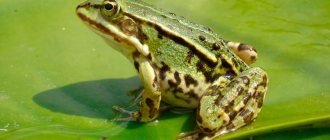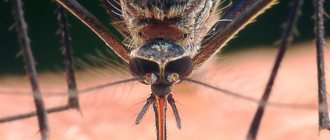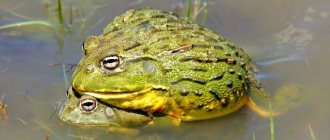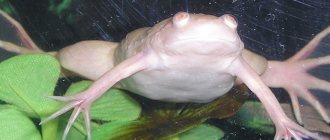In the animal world, external beauty is often closely linked to real threat. Poisonous animals with a bright and attractive appearance can warn that they are dangerous. At the same time, amphibians, including frogs, have a special warning effect. If a person sees a very unusual and beautiful frog, it is not advisable to be near it or touch it. Otherwise, in the first moments a significant dose of poison will be received, which will poison all organs and even lead to death. So, which frogs are considered the most dangerous?
Poisonous African frog
In its homeland, the frog is also known as “ cocoi ”. The second name was given by African Indians. Despite the fact that amphibians of this species have strong poison, Africans try to catch them. This desire is explained by the fact that frogs produce valuable and expensive poison. Even potassium cyanide cannot compare with the poison released, despite the fact that toxic substances are produced gradually.
The length of the poisonous African frog is only 3 centimeters . At the same time, the bright and unusual color helps to ensure attention.
Poisonous African frogs live not only in South Africa, but also in America and Madagascar.
Antidote for frog poison
Nowadays, scientists have learned to synthesize batrachotoxin, which is not inferior in its characteristics to natural one, but have never been able to obtain an antidote to it. Due to the lack of an effective andidote, all manipulations with poison dart frogs, in particular the terrible leaf climber, must be extremely careful. The toxin affects the heart, nervous and circulatory systems, entering through abrasions/cuts in the skin, so a poisonous frog caught in the wild should not be handled with bare hands.
Return to content
Bicolor phyllomedusa
Phyllomedusa bicolor lives in the Amazon forests. If you encounter one, you need to be especially careful. The frog's body looks truly attractive. It was the bright color that turned out to be the main trump card of the representative of the amphibian world.
Any person who touches a phyllomedusa will receive a strong dose of poison. Then the person will begin to die, experiencing terrible convulsions and hallucinations. Despite this risk, the tribes living in the Amazon forests are not afraid of the poison of the frog, since it is with its help that in tiny doses they enter into a trance when performing rituals.
Poison tree frog / Trachycephalus venulosus
A rather large frog, growing up to 9 cm in length, comes from Brazil, which is why it is also called the Brazilian tree frog.
It has an unusual coloration, consisting of spots of various sizes, forming a concentric pattern throughout the body. A distinctive feature is also the small red spots on the back and neck of the amphibian.
They prefer to live most of their lives in trees, and during breeding periods they move closer to bodies of water. Females lay eggs in ponds and lakes, which can dry out, but the offspring still survive early.
By the way, if you haven’t looked at our article about the most unusual species of frogs, be sure to do so!
6
golden frog
The golden frog, also called the dire frog , lives on the Colombian coasts. These representatives of amphibians love wet and hot weather. It is important to note that golden frogs often live in areas where air humidity reaches 90 percent. Moreover, in the forest these amphibians can only be found in groups of 5–6 individuals.
If you look at the terrible leaf climber, you might be surprised by this name. Amphibians are distinguished by their harmless color and small size. In addition, the behavior of frogs is surprising in their calmness. However, the terrible leaf climber still turns out to be a dangerous reptile. History has even recorded a case of death, and the death of a person occurred instantly.
Why is the leaf climber so dangerous? The skin of this species of frog is covered with special alkaloids that produce a strong poison called batrachotoxin. The steroid alkaloid can block the functioning of vital organs, paralyze the nervous system, develop severe arrhythmia and heart failure. It is almost impossible to survive after this.
The more beautiful, the more dangerous
In the animal world, often, the external beauty of an animal is a kind of danger signal . Their bright appearance and color warn of a threat to life. An example of this is amphibians, which include frogs.
The most poisonous frogs on the planet are endowed with a very beautiful and bright appearance. However, just one touch to them can kill you. The most dangerous of them live in the forests of South and Central America. Most often they are found in the following areas:
- Colombia,
- Ecuador,
- Venezuela,
- Guianas.
They live in the green vegetation of the local jungle. Brightly colored reptiles can be easily spotted among such vegetation. Unlike other reptile species, they are active during the daytime. At night, poisonous frogs rest. They live mainly in lowlands, near the banks of streams in the humid tropics.
A beautiful view in this case serves as a sign of terrible danger . These frogs should not be touched because their poison is fatal. It is produced in the skin of an amphibian creature and is contained in its mucus. When it comes into contact with a person's skin, the nerve endings are blocked. From one touch a person receives a lethal dose of poison, his organs are poisoned and he dies. General detoxification sometimes leaves a chance for survival. Which of these beautiful frogs is the most dangerous on the planet?
yellow frog
This amphibian is also called the golden frog and it is the most poisonous on the planet. Yellows belong to the poison dart frog family. These beautiful amphibians have one thing in common: the deadly poison they secrete.
The terrible leaf crawler is equipped with a poison called batrachotoxin. Its dimensions reach 2-4 cm and its limbs are devoid of membranes.
Instead, at the ends of the fingers there are expanded disks that act as suction cups. Such discs perfectly help the reptile move along branches and leaves of vegetation.
Males and females do not differ in size, but only in bright contrasting colors. Frogs are quite active, but only during the daytime. They feed on ticks, ants and other small insects. If the terrible leaf climber remains without food for 3-4 days, it may die. Most of them are found in tropical forests. Local tribes use their poison to process arrows . One frog is enough to lubricate several dozen tips.
Spotted dart frog
The spotted poison dart frog looks stunningly beautiful. The head and body of this bright frog are decorated with dark yellow circles. Black and blue circles are visible on the paws. This amazingly beautiful reptile can have a wide variety of skin colors. The body size of the spotted poison dart frog does not exceed 3 cm, but this does not prevent it from paralyzing the largest animal with its poison. The worst thing is that an antidote has not yet been invented in the world.
The Amazon natives use the poison of the spotted dart frog to lubricate arrows for hunting and defense and change the color of the feathers of parrots.
Blue dart frog
This creature fascinates with its unusual beauty. This species cannot be called small, since the body size is about 5 cm. The frog’s body is covered with beautiful patterns. The color is based on a rich blue color, with black dots and streaks scattered throughout. There are very few of them left on earth and now blue dart frogs are found only in Suriname. They live in small groups. Since the creatures are terribly poisonous, they have no natural enemies. Reptiles feel confident because they are untouchable.
Cocoa frog
The tiny cocoa frog reaches a size of 2-3 cm, and its weight is slightly more than 1 gram. Such a frog can easily fit in a teaspoon. She lives in Colombia. When cocoa poison gets on another animal, it dies in terrible pain. The poison paralyzes the respiratory system. The slightest touch from the tiny reptile causes instant death.
Bicolor phyllomedusa
Another type of deadly amphibian is also found in the Amazon forests. The two-colored phyllomedusa always stands out with its color against the background of vegetation. The upper part of her body is bright light green and slightly yellowish. The second side is brown with light spots. It is also called the frog monkey because it can climb anywhere in search of adventure. Its venom causes hallucinations and severe stomach upset.
Three-striped leaf climber
The three-striped leaf climber is a truly dangerous amphibian. Despite the potential harm, there is a chance of benefit. The tribes that live with this type of leaf climber have learned to extract beneficial properties.
Frogs live in Ecuador. The amphibian creature is small in size, but at the same time it can produce strong poison and kill any person or animal. Despite this, in the last century, scientists and researchers nevertheless began to breed 3-banded leaf climbers artificially, since the use of a certain dosage of the produced poison guarantees the successful elimination of pain. In this case, the effectiveness is higher than that of morphine.
Caring parents and wonderful hunters
A leaf climber family usually consists of several females and only one male. This develops a sense of ownership in the male; he protects his territory in every possible way. Unlike other reptiles, females spawn on land rather than in water. Usually she lays 15-30 eggs in damp and dark thickets. This is where her mission ends.
The female leaves and after that it is the turn of the future father. He actively takes care of his offspring:
- pours water on them,
- protects
- turns over with hind legs.
Tadpoles appear after a few days. The caring father moves them on his back to the pond. In an aquatic environment they develop within 2-3 weeks. After this, small frogs appear, which go out onto land and begin an independent life.
However, after this, the young live for a long time with their parents or near them. This period drags on until the children start their own families.
Red-backed poison frog
Red-backed poison frogs live in Peru. These amphibians have moderate poison, which can significantly worsen human health. In this case, some animals that receive the produced poison die.
Red-backed poison frogs eat in a special way. Their diet should include a poisonous ant. In this case, the produced poison is stored in the skin glands, and it can be released only as needed. Most often, the poison is released when the amphibian is in danger.
What to do?
First aid consists of abundant rinsing of the mouth, for example, with a stream from a hose (or syringe). At the same time, the cat's head should be lowered down so that water does not get into the throat, and she cannot swallow it. Then, if possible, wipe the cat's teeth with a damp cloth and give her activated charcoal.
Since amphibian venom is highly toxic to animals (even fatal), your pet should be examined by a veterinarian.
But eating frogs, not necessarily poisonous ones, carries another danger.
Spotted dart frog
The spotted poison dart frog is amazingly beautiful. Moreover, beauty is due to multi-colored skin.
It is important to note that the skin of the spotted poison dart frog is poisonous. It is interesting to note that the poison has a special effect on parrots. Amazon tribes noticed that the color of parrot feathers changes under the influence of the venom of the spotted dart frog.
Human use of poison
Previously, the mucus of poisonous frogs was used for its intended purpose - to hunt game and destroy enemies. The skin of the American spotted poison dart frog contains so much poison (BTXs + homobatrachotoxin) that it is enough for dozens of arrows that can kill or paralyze large animals. The hunters rubbed the tips on the back of the amphibian and tucked the arrows into their blowguns. In addition, biologists have calculated that the poison of one such frog is enough to kill 22 thousand mice.
According to some sources, the role of a primitive drug was the poison of the aga toad: it was simply licked from the skin or smoked after drying it. Nowadays, biologists have come to the conclusion that the poison of Bufo alvarius (Colorado toad) is a more powerful hallucinogen - it is now used for relaxation.
Epibatidine is the name of the component found in batrachotoxin. This painkiller is 200 times stronger than morphine and is not addictive. True, the therapeutic dose of epibatidine is close to lethal.
Also, from the skin of tailless amphibians, biochemists have isolated a peptide that prevents the multiplication of the HIV virus (but this research has not yet been completed).
Return to content
Charming leaf climber
The charming leaf climber is considered poisonous, but it is less dangerous than other representatives of its genus. However, many victims may bitterly regret that they tried to attack him.
The charming leaf climber attracts only with its beautiful appearance. However, it lives in Central America and can be found fairly quickly. Venomous creatures are almost always willing to attack if they perceive a threat.
Toads
In our country, common toads are the gray toad (gray-brown on top and yellowish below), the green toad (its lumpy skin is grayish-olive in tone with green spots), the reed toad (less lumpy, with a light stripe along the back) and the similar Mongolian toad .
There are many poisonous glands on the skin of toads, among them two large suprascapular (behind the eyes) glands, which can “shoot” poisonous secretions at a distance of up to 1 m. Small glands are located on the head, body and legs. They are the first to fire at the moment of danger, releasing an odorous secretion with a bitter taste, causing a burning sensation and vomiting in the attacking predator.
A positive point: toads are nocturnal animals and only occasionally crawl out of secluded corners during the day.
Spotted poison frog
The spotted poison frog lives in the tropical forests of Peru and Ecuador. Moreover, the poison of one amphibian creature is enough to kill 5 people at once. The frog looks cute, but you can't touch it. Despite this danger, you should not be afraid of meeting a spotted poison frog, since it never attacks first.
The beautiful appearance of frogs does not always indicate that contact with them will be useful. There is often a real risk associated with the poison produced, so extra caution is advisable.
What poison do frogs have?
Tailless animals signal their toxicity with a deliberately striking coloration, which is also reproduced by completely non-toxic species in the hope of escaping from enemies. True, there are predators (for example, the gigantic salamander and the ringed snake) that calmly consume poisonous amphibians without harm to their health.
The poison poses a serious threat to any living creature not adapted to it, including humans, which, at best, ends in poisoning, and at worst, death. Most tailless amphibians produce a poison of non-protein origin (bufotoxin), which becomes dangerous only in a certain dosage.
The chemical composition of the poison, as a rule, depends on the type of amphibian and includes different components:
- hallucinogens;
- nerve agents;
- skin irritants;
- vasoconstrictors;
- proteins that destroy red blood cells;
- cardiotoxins and others.
The composition is also determined by the habitat and living conditions of poisonous frogs: those of them who sit a lot on land are armed with toxins against land predators. The terrestrial lifestyle has influenced the poisonous secretion of toads - it is dominated by cardiotoxins that disrupt the activity of the heart.
Fact. The soapy secretions of toaded fireweeds contain bombesin, which leads to the breakdown of red blood cells. Whitish mucus irritates human mucous membranes, causing headaches and chills. Rodents die after ingesting bombesin at a dose of 400 mg/kg.
Despite their toxicity, toads (and other poisonous anurans) often end up on the table of other frogs, snakes, and some birds and animals. The Australian raven lays the aga toad on its back, kills it with its beak and eats it, discarding its head with poisonous glands.
The venom of the Colorado toad consists of 5-MeO-DMT (a strong psychotropic substance) and the alkaloid bufotenine. Most toads are not harmed by their poison, but this cannot be said about frogs: a tiny leaf climber can die from its own poison if it enters the body through a scratch.
Several years ago, biologists from the California Academy of Sciences found a bug in New Guinea that “supplies” batrachotoxin to frogs. Upon contact with the beetle (the natives call it Choresine), tingling and temporary numbness of the skin occurs. Having examined about 400 beetles, the Americans discovered different, including previously unknown, types of BTXs (batrachotoxins) in them.
Return to content
Alariasis
– helminthiasis, the causative agent of which is the trematode Alaria alata, which parasitizes the stomach and intestines of animals. Additional hosts for these worms are frogs and tadpoles. If a cat catches and eats a frog or tadpole infected with alaria larvae, it will become ill with alariasis.
What to do? As always, worm your pet regularly!
So, if your ward is walking in nature:
- you should find out whether there are toads, toads or spadefoots in your area (to know the enemy by sight)
- if you notice a lot of foam from the mouth of your pet or other signs indicating contact with a poisonous frog or toad, you need to rinse his mouth and, if necessary, take him to the clinic;
- Don’t forget to give anti-worm medications on time(!)
Source: CatiCat.ru
Blue Darter / Dendrobates azureus
A graceful creature, as seen in the photo, with a characteristic blue color, prefers savannas and tropical forests, feeding mainly on small insects.
Even a small concentration of poison is enough to kill large natural enemies, and history has recorded fatal cases among humans. They grow up to 5 cm in length and live among foliage, gathering in groups of up to 50 individuals.
Despite the mortal danger, wildlife lovers keep an American resident as a pet.
10
Yeah / Rhinella marina
The poisonous tropical toad takes an honorable second place among all toads, but in terms of its toxicity it is the leader among poisonous amphibians.
The largest specimen reached a size of 24 cm, although on average the toad grows from 15 to 17 cm. It comes from Central America, but to fight insects they were brought to Australia, from where Aga settled on the islands of Oceania.
The strongest poison affects the heart and affects the nervous system. The most dangerous thing is that the green toad can shoot poison from a distance.
one
Striped leaf climber / Phyllobates vittatus
These colorful frogs, native to southwest Costa Rica, with their attractive appearance, are a warning that they are dangerous and that it is best to avoid these wonderful creatures.
Easily recognized by the characteristic yellow stripe running along the back. The stripes run both on the head and on the sides of the belly, which is how the frog gets its prominent name.
It is not possible to notice it right away, since it prefers to hide in ravines and among stones. The poison, when it gets on human skin, causes severe pain and can even lead to paralysis.
11
